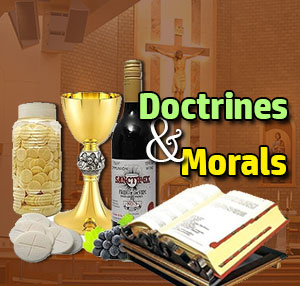CHRISTMAS: THE INCARNATION OF THE SON OF GOD
“The miracle of miracles” as St Thomas terms the mystery of the Incarnation, took place because “God could in no other way demonstrate his love for us than by descending for our sakes to a lowly estate,” adds St Gregory Nazianzen. “The unspeakable Wise wisely became an Infant,” says St Augustine. Naturally then, “Let us also go to Bethlehem!” exclaims St Bernard, “There, we have something to love, to admire and to imitate!” This is the miraculous drama that took place when heaven touched earth and God became man! The silent, holy night when “what the human mind could never have conceived, or hoped for, God has bestowed upon us,” says St John Chrysostom.
Christmas is “Christ’s Mass” or “Mass of Christ.” Christmas Day is the Birthday of Life! It is the day of the year when the Catholic Church celebrates the feast of the coming of the Second Person of the Blessed Trinity in flesh and blood in human history.
December 25 in all probability came to be accepted as the birthday of Jesus as it was on this day (25 December according to the Julian calendar, 6 January according to the Egyptian), the time of the winter solstice, that is, a time when the dying sun began its steady climb into the northern skies, that the pagans celebrated the dies natalis Solis Invicti - the birthday of the invincible sun. Moreover, the sun god had been proclaimed patron of the Roman Empire, with a temple dedicated to him, on 25 December 274, by Emperor Aurelian.
“Who indeed is as unconquerable as our Lord?” asks St John Chrysostom (4th century), “He is the ‘Sun of Justice!” Thus, the new feast celebrating the Incarnation of the God-man, his “manifestation in the flesh” gave suitable liturgical expression to the profession of faith drawn up by the Council of Nicaea in 325.
Since the 4th century, Popes have been celebrating three Masses at Christmas, the readings of each being different showing the “three fold birth of Christ” (1) The “Mass of the Angels” at midnight, held in the great Basilica of St Mary Major, where the relics of the manger were preserved. (2) The “Mass of the Shepherds” celebrated at dawn in the Church of Anastasia, commemorating the human birth of “the Light of lights,” “the Word made flesh in the Virgin’s womb.” (3) The solemn Mass celebrated in St Peter’s around 9.00 am for the birth of the Lord in the hearts of the faithful. Since the time of Pope St Gregory the Great, the Church has extended this to every priest.
The Holy Eucharist is the continuation of Christ’s incarnation on earth. The mystery of the Eucharist gives us the joy of having Christmas everyday. When we come to the Blessed Sacrament, we come to Bethlehem, a name which means “House of Bread.” Jesus chose to be born in Bethlehem because He would dwell with us forever as the “Living Bread” come down from heaven. The Eucharist is Divine Love made visible in the Sacred Host! This is why the angels continue to sing to him as they did in Bethlehem “Glory to God in the highest and peace to men of good will.” Jesus continues to come to us “filled with enduring love” as the Word becomes flesh in the Holy Eucharist and makes His dwelling among us. “It is He who is our peace.”
Christmas is an occasion of rejoicing, a season of goodwill, a time of joy. For us Christians, it is the second of our greatest annual feasts (next after Easter) in which we call to mind God’s infinite love for us and his infinite mercy towards us mortals.
Christmas Day is the day we commemorate the greatest, the mightiest, the most far-reaching event which ever took place in human history. History is rightly divided into two eras: before and after Christ. His coming started a new era for the whole humanity (even atheists admit this). We date our years, B.C. means Before Christ, and A.D i.e. Anno Domini - the years of the Lord, the years which have elapsed since Christ came to assume the kingship of the world.
Christmas - the Incarnation of the Son of God, has given us the means and has shown us the way to get to heaven. Christians worthy of the name strives to be good and kind to his fellowmen - all the year round and throughout his life time.
The popular Catholic custom of adoring the Holy Infant in the Christmas Crib owes its origin to the creative spirituality of St Francis of Assisi who in 1223, recreated the setting of the manger - birth, complete with Live ox and ass, in a forest - cave near Greecio. Our Lord is born under the earth, for the stable was in a cave. Hence, all who wish to see him must bend, must stoop - the mark of humility.
Furthermore, this originated Christmas Carols in Italy, whereas German Christmas songs and “Noels” came into existence in the 11th and 12th centuries.
Candles on a tree were first mentioned in a 13th century epic. The “Christmas Tree” that is popular today is most likely of German origin, and symbolizes the “tree of Life” in the Garden of Eden and of the Tree of the Cross.
St Nicholas’ generosity and kindness became a tradition by the Myra Christians after his death. They honoured his memory by leaving surprise gifts for their children by their bedside during the night before his anniversary. This tradition gradually got transferred to our Christmas, and “Saint Nicholas” has in popular parlance become corrupted to “Santa Claus”!
In 1844, W.C.T. Dobson sent the first Christmas card. In 1846, Sir Henry Cole and J.C. Horsley produced the first commercial Christmas card. They were printed in 1870.
One Christmas, Santa Claus gave a boy a toy engine which he took to the convent. While his mother and the nuns were discussing old times, the boy was busy playing with the toy. Later, a young nun came and took him and others to the crib. The boy said, “While I saw the Holy Child in the manger, I was distressed because little as I had, he had nothing at all. For me, it was a fresh proof of the incompetence of Santa Claus.” The boy politely asked the young nun if the Holy Child didn’t like toys. She replied composedly enough, “oh, he does but his mother is too poor to afford them.” The boy thought his own mother could afford to buy him a box of crayons. He distinctly remembered getting into the crib and putting the engine between his outstretched arms. However, he could not vividly remember showing the baby how to wind it as well, because a baby like that would not be clever enough to know! Unfortunately, the boy remembered too the tearful feeling of reckless generosity and the mighty darkness of the chapel, clutching his toy engine to his chest! It is Christmas in the heart that puts Christmas in the air. See Christ in your neighbours! (Mt 25: 35-46).
God, grant us the light of Christmas, which is faith; the warmth of Christmas, which is love; the radiance of Christmas, which is purity; the righteousness of Christmas, which is justice; the belief in Christmas which is truth; the all in Christmas, which is Christ. Merry Christmas to you!
© 2024 - Catholic Archdiocese of Ibadan





